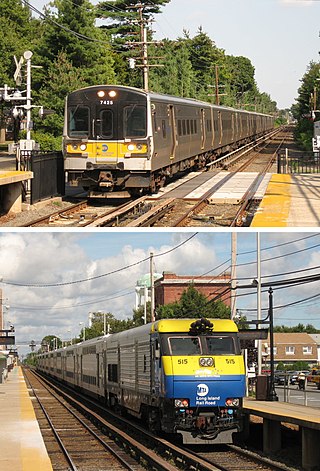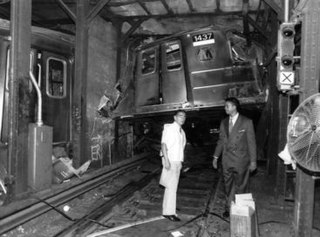
The Long Island Rail Road, or LIRR, is a railroad in the southeastern part of the U.S. state of New York, stretching from Manhattan to the eastern tip of Suffolk County on Long Island. The railroad currently operates a public commuter rail service, with its freight operations contracted to the New York and Atlantic Railway. With an average weekday ridership of 354,800 passengers in 2016, it is the busiest commuter railroad in North America. It is also one of the world's few commuter systems that runs 24/7 year-round. It is publicly owned by the Metropolitan Transportation Authority, which refers to it as MTA Long Island Rail Road. In 2023, the system had a ridership of 75,186,900, or about 276,800 per weekday as of the second quarter of 2024.

Chinatown bus lines are discount intercity bus services in the United States, often operated by Chinese Americans, primarily Fujianese. They operate with lower overhead and lower fares compared to competing services. Destinations include most major cities as well as casinos popular with Asian Americans.
The Carrollton bus collision occurred on May 14, 1988, on Interstate 71 in unincorporated Carroll County, Kentucky. The collision involved a former school bus in use by a church youth group and a pickup truck driven by an alcohol-impaired driver. The head-on collision was the deadliest incident involving drunk driving and the third-deadliest bus crash in U.S. history. Of the 67 people on the bus, there were 27 fatalities in the crash, the same number as the 1958 Prestonsburg bus disaster, and behind the 1976 Yuba City bus disaster (29) and 1963 Chualar bus crash (32).

The transportation system of New York City is a network of complex infrastructural systems. New York City, being the most populous city in the United States, has a transportation system which includes one of the largest and busiest subway systems in the world; the world's first mechanically ventilated vehicular tunnel; and an aerial tramway. New York City is home to an extensive bus system in each of the five boroughs; citywide and Staten Island ferry systems; and numerous yellow taxis and boro taxis throughout the city. Private cars are less used compared to other cities in the rest of the United States.
The Huntsville bus crash involved a school bus carrying 40 students from Lee High School and a car, both heading to the Huntsville Center for Technology, which occurred on November 20, 2006, on an elevated portion of Interstate 565 in Huntsville, Alabama.
The Bluffton University bus crash was an automobile crash that occurred during the early morning hours of March 2, 2007, on Interstate 75 in Atlanta, Georgia. A chartered motorcoach was carrying 33 members of the Bluffton University baseball team from Bluffton, Ohio, on their way to play Eastern Mennonite University during spring break in Sarasota, Florida. The group planned to travel without an overnight stop on the approximately 900-mile, 18-hour trip. The trip went without incident from Bluffton south to a motel in Adairsville, Georgia, at which time a relief driver began operating the bus for the second half of the trip.

The Bx12 is a public transit line in New York City running along the 207th Street Crosstown Line, within the boroughs of Manhattan and the Bronx. The line runs along 207th Street in Upper Manhattan and along the continuous Fordham Road and Pelham Parkway in the Bronx.

MTA Regional Bus Operations (RBO) is the surface transit division of the Metropolitan Transportation Authority (MTA). It was created in 2008 to consolidate all bus operations in New York City operated by the MTA. As of February 2018, MTA Regional Bus Operations runs 234 local routes, 71 express routes, and 20 Select Bus Service routes. Its fleet of 5,840 buses is the largest municipal bus fleet in the United States and operates 24/7. In 2023, the system had a ridership of 730,924,600, or about 2,531,200 per weekday as of the second quarter of 2024.
The Snow Hill school bus collision was a vehicle accident that occurred on May 31, 1985, on US 13 near Snow Hill, North Carolina. Four vehicles were involved, including a school bus operated by the Greene County Schools. Six students and Carson Lee Conger, 27, of Norfolk, Virginia, were killed. The remaining 24 persons in the accident suffered injuries ranging from minor to critical.

Main Street is a major north–south street in the borough of Queens in New York City, extending from Queens Boulevard in Briarwood to Northern Boulevard in Flushing. Created in the 17th century as one of Flushing's main roads, Main Street has been lengthened at various points in its existence.

On the morning of December 1, 2013, a Metro-North Railroad Hudson Line passenger train derailed near the Spuyten Duyvil station in the New York City borough of the Bronx. Four of the 115 passengers were killed and another 61 injured; the accident caused $9 million worth of damage. It was the deadliest train accident within New York City since a 1991 subway derailment in Manhattan, and the first accident in Metro-North's history to result in passenger fatalities. The additional $60 million in legal claims paid out as of 2020 have also made it the costliest accident in Metro-North's history.

On August 28, 1991, a 4 Lexington Avenue Express train on the New York City Subway's IRT Lexington Avenue Line derailed as it was about to enter 14th Street–Union Square station, killing five people. It was the worst accident on the subway system since the 1928 Times Square derailment. The motorman was found at fault for alcohol intoxication and excessive speed, and served time in prison for manslaughter.

On the evening of February 3, 2015, a commuter train on Metro-North Railroad's Harlem Line struck a passenger car at a grade crossing near Valhalla, New York, United States, between the Valhalla and Mount Pleasant stations, killing six people and injuring 15 others, seven very seriously. The crash is the deadliest in Metro-North's history, and at the time the deadliest rail accident in the United States since the June 2009 Washington Metro train collision, which killed nine passengers and injured 80.

The 2015 Oxnard train derailment occurred on February 24, 2015, at 5:44 a.m. local time when a Metrolink passenger train collided with a truck that a driver had mistakenly turned from Rice Avenue onto the tracks and became stuck. After the impact, the train derailed at Oxnard, California, United States. As a result of the crash, the train engineer died from his injuries a week later and 32 passengers and crew members were injured. The truck driver exited his vehicle and ran from the scene prior to the crash; he sustained minor injuries that were unrelated to the crash sequence.

Since 1963, New York City has been using a system of bus lanes that are intended to give priority to buses, which contain more occupants than passenger and commercial vehicles. Most of these lanes are restricted to buses only at certain days and times, but some bus lanes are restricted 24/7. As of May 2021, there are 138.4 miles (222.7 km) of bus lanes within New York City.

In the New York metropolitan area, dollar vans are a form of semi-formal public transportation. Dollar vans serve major corridors in Brooklyn, Queens, and the Bronx that lack adequate subway and bus service. A variant of the dollar van, the jitney, also serves areas in eastern New Jersey and transports them to Manhattan.

The Q20A and Q20B and Q44 bus routes constitute the Main Street Line, a public transit line in Queens, New York City, running primarily along Main Street between two major bus-subway hubs in the neighborhoods of Jamaica and Flushing. The Q20A/B terminates in College Point at the north end of Queens. The Q44 continues north into the borough of the Bronx, terminating in the West Farms neighborhood near the Bronx Zoo. The Q44 is one of two Queens bus routes to operate between the two boroughs.
The Bx23 and Q50 bus routes constitute a public transit corridor in New York City, running from the Flushing neighborhood in Queens to the Pelham Bay and Co-op City neighborhoods in the Bronx. The Bx23 provides local service in Pelham Bay and Co-op City, while the Q50 provides limited-stop service between Co-op City and subway hubs in Pelham Bay and Flushing. Both routes are city-operated under the MTA Bus Company brand of MTA Regional Bus Operations, and are the only two local routes in the Bronx to operate under the MTA Bus brand, rather than under the MaBSOTA brand that all other Bronx bus routes operate under.

In the early afternoon of October 6, 2018, a stretch limousine crashed at the junction of New York state routes 30 and 30A, north of Schoharie and 30 miles west of Albany. The crash killed 20: the driver, all 17 passengers, and two pedestrians who were in a nearby parking lot. The passengers were mostly from communities around the Capital District, primarily Amsterdam, and were on their way to celebrate a birthday at Brewery Ommegang near Cooperstown. Among them were four sisters and two recently married couples.

The 2020 Pennsylvania Turnpike crash occurred in Mount Pleasant, Pennsylvania, on the Pennsylvania Turnpike in icy conditions at around 3:40 am on January 5, 2020. It was sparked by a 52-passenger tour bus traveling downhill, which struck an embankment and flipped on its side, causing a chain-reaction crash of two UPS trucks, a FedEx truck, and at least one other vehicle. Five people were killed, at least 60 people were injured, and an 86-mile (138 km) stretch of the Pennsylvania Turnpike was shut down in both directions as the crash was being investigated.














